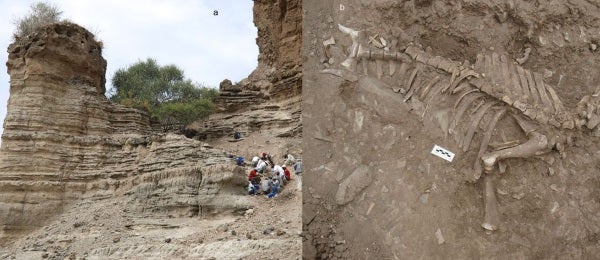This article was published in Scientific American’s former blog network and reflects the views of the author, not necessarily those of Scientific American
On supporting science journalism
If you're enjoying this article, consider supporting our award-winning journalism by subscribing. By purchasing a subscription you are helping to ensure the future of impactful stories about the discoveries and ideas shaping our world today.
As creature features go, 1996's The Ghost and the Darkness can take pride in being one of the better ones. There's no radiation-enhanced monstrosities or mad science here. Instead there is only a duo of hungry, hungry lions - their reign of terror loosely-based on real events that unfolded in Tsavo, Kenya in 1898 - that foil Val Kilmer and Michael Douglas at almost every turn as the cats chew their way through a railway labor camp.
Of course, the Hollywood lions are larger than life. The film versions have big, bushy manes while the actual Tsavo lions - which you can visit at Chicago's Field Museum - have a little fauxhawk, at best. Their kill count is inflated, too. The real life lion-hunter John Henry Patterson asserted the Tsavo lions claimed 135 victims, and while the movie stuck to this story more recent research puts the toll closer to a lesser-but-still-horrific 35.
The greatest cinematic exaggeration, however, is when Kilmer and Douglas pay a visit to the lions' den. Not content with the grassland, the film's bloodthirsty lions take up in a cave littered with the bones of their victims. "Lions don't do this," Douglas whispers in the dark, "Lions... never had a lair like this," and he's right. Lions are cats of the open country, and no one has ever found one of the felids hoarding bones in the darkness, yet I couldn't help but think of the movie's shadowy scene when I noticed a new paper on lion behavior. At one spot in Tanzania's Olduvai Gorge, it appears that lions truly did gather bones.
Even though Olduvai is best known for the prehistoric humans found there, today the spot is part of the great Serengeti ecosystem that stretches across Kenya and Tanzania. And it was in the modern deposits atop the ancient Olduvai rocks that paleontologist Mari Carmen Arriaza and colleagues examined a wildebeest graveyard that was likely brought together by lions.

The Olduvai wildebeest graveyard. From Arriaza et al., 2016.
Arriaza and coauthors published a paper on the strange site last year. The remains of at least 55 blue wildebeest - 50 adults, 5 yearlings - were uncovered at Olduvai, some almost intact but many missing vertebrae and ribs. The cause of this assemblage was not drought nor disease. The wildebeest were carried here, a follow-up study reports, and their bones suggest big cats were responsible.
The fact that the researchers found so much of the skeletons was a crucial clue. Spotted hyenas, which also lope around the Serengeti, usually don't leave their kills intact for very long. These giggling carnivores tear prey apart and often transport pieces - a leg, part of the spine, or other detached morsel - to quieter spots where lions can't bully them away. Big cats have different table manners. Leopards typically drag whole carcasses away to their preferred dining spots, so having mostly-intact bodies indicated some kind of felid. More than that, only about 7% of the bones at Olduvai showed any kind of carnivore damage compared to between 34 and 44% of those found at studied hyena dens. This indicates the blue wildebeest were likely killed and eaten by carnivores that specialize on flesh rather than breaking bone. A big cat was the culprit.
There are three big cats in the Serengeti: the lion, the leopard, and the cheetah. Adult blue wildebeest are too large for cheetahs to assault, though, and leopards have only seldom been seen to take down the hefty herbivores. The conclusion is an inference, Arriaza and coauthors concede, but lions are the most likely carnivores responsible for the wildebeest accumulation, and this is the first time that anyone has found evidence of lions creating such a boneyard.
Not that lions were the only agents responsible for patterns seen in the bones. The researchers note that some skeletons show signs of "postdepositional ravaging" by hyenas - which may explain the relative scarcity of ribs, vertebrae, and other bones they regularly crunch - and some bones may have been washed down a steep slope by seasonal rains. But the reason so many blue wildebeest were laid out in one place is likely because of lions.
Up until now, lions were thought to eat where they make their kills. The Olduvai site suggests that sometimes these tawny cats do otherwise, dragging bodies away to a secluded spot just like their smaller cousins the leopards. And this goes beyond adding a new quirk to lion behavior. It may also change the way we view our own past.
Paleoanthropologists have been debating how prehistoric humans got their meat for decades, particularly in the millions of years before hunting became a regular part of our skillset. Did Pliocene people power scavenge, driving predators off kills, or did they just pick up leftovers? The argument will go on, but the fact that lions sometimes gather bones in a small space might alter views of fossil bonebeds. Skeletal accumulations too big to have been made by a leopard but lacking hyena damage cannot be automatically attributed to humans. Lions have now padded onto the field as contenders, gathering an osteological record of history in the remainders of their meals.
Reference:
Arriaza, M., Domínguez-Rodrigo, M., Yravedra, J., Baquedano, E. 2016. Lions as bone accumulators? Paleontological and ecological implications of a modern bone assemblage from Olduvai Gorge. PLOS ONE. doi: 10.1371/journal.pone.0153797